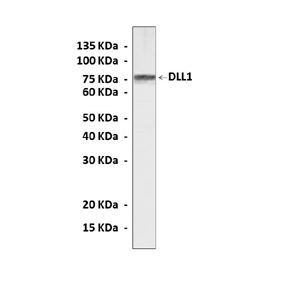Anti-DLL1: Monoclonal Delta-Like Ligand 1 Antibody |
 |
BACKGROUND The Notch pathway is an evolutionarily conserved signaling mechanism that plays crucial roles in cell fate during embryonic development and in the adult. The pathway is activated when one of the Notch ligands, a transmembrane protein present at the surface of a signal-sending cell, binds to a Notch receptor present in a signal-receiving cell. In mammals, there are five Notch ligands – three Delta-like ligands (official symbols DLL1, DLL3 and DLL4) and Jagged 1 and Jagged 2 (JAG1 and JAG2), and four Notch receptors (Notch-1 to Notch-4).1 Notch-1 protein consists of an extracellular domain with 36 epidermal growth factor–like repeats, a single transmembrane domain, and an intracellular domain containing a RBP-JK-associated molecule (RAM) region, ankyrin domains, and a proline-glutamate-serine-threonine-rich (PEST) region. Activation of Notch-1 signaling is thought to occur via juxtacrine binding of an adjacent cell's Delta-like or Jagged at Notch epidermal growth factor regions 11 and 12. After this binding, two enzymatic cleavages occur to liberate the Notch intracellular domain (NICD) from the plasma membrane. Similar processing also releases the Delta-like and Jagged intracellular domains in the adjacent cell. The NICD translocates into the nucleus and binds to members of the CSL transcription factor family, thought to mediate most of the downstream effects of Notch signaling. Following NICD binding, the CSL family member CBF-1/RBP-JK, normally part of a co-repressor complex with histone deacetylase 1, becomes a transcriptional activator. Downstream targets of CBF-1 include a large family of ß helix loop helix (bHLH) transcription factors known as the hairy/enhancer of split (HES) genes. Whereas the activated intracellular domains of Delta-like and Jagged are also thought to perform signaling functions, these functions are as yet uncharacterized.2 Depending on the cell type, Notch signaling can positively or negatively influence proliferation, differentiation, and apoptosis.
The DLL1 gene is expressed in the corticomedullary region of the newborn mouse thymus and in fetal and adult human hematopoietic tissues.3 Moreover, a soluble form of human Delta-1 was shown to delay the acquisition of differentiation markers by murine hematopoietic progenitors and to promote the expansion of primitive precursors.3 In adiition, DLL1 was shown to play important role for arteriogenesis.4
REFERENCES
1. Artavanis-Tsakonas, S. et al: Science, 284:770–6, 1999.
2. de La Coste, A. & Freitas, A. A.: Immunol. Lett. 102:1-9, 2006.
3. Han, W. et al: Blood, 95:1616–1625, 2000.
4. Limbourg, A et al: Circ Res. 100:363-71, 2007.
2. de La Coste, A. & Freitas, A. A.: Immunol. Lett. 102:1-9, 2006.
3. Han, W. et al: Blood, 95:1616–1625, 2000.
4. Limbourg, A et al: Circ Res. 100:363-71, 2007.
Products are for research use only. They are not intended for human, animal, or diagnostic applications.
Параметры
Cat.No.: | CC10003 |
Antigen: | An E. coli-expressed purified recombinant fragment of human DLL1 (aa 8-168) |
Isotype: | Mouse Monoclonal IgG2b |
Species & predicted species cross- reactivity ( ): | Human, Rat, Mouse |
Applications & Suggested starting dilutions: | WB 1:1000 IP 1:50 IHC n/d ICC n/d FACS n/d |
Predicted Molecular Weight of protein: | 78 kDa |
Specificity/Sensitivity: | Detects endogenous levels of DLL1 proteins in various cell lysates. |
Storage: | Store at -20°C, 4°C for frequent use. Avoid repeated freeze-thaw cycles. |
*Optimal working dilutions must be determined by end user.
Документы
Информация представлена исключительно в ознакомительных целях и ни при каких условиях не является публичной офертой








